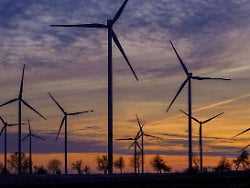Thursday, January 13, 2022
Government should expand rapidly
Wind power industry: Need space and lines
With the change of government, the wind power industry is hoping for a speedy expansion of new systems. In the end, this almost came to a standstill. But the federal government’s ambitious plans require three things above all: lots of space, thousands of kilometers of power lines and faster approval processes.
The German wind industry is urging the expansion of wind power in the North and Baltic Seas to be quick. After the emergency braking caused by politics in the past two years, wind energy manufacturers and operators now believe that tenders, planning and approval procedures for new turbines must be accelerated immediately “in order to avoid further loss of time,” according to the joint annual report of several industry associations. In view of the significantly more ambitious targets set by the new federal government, “it must be a matter of raising all the potential for acceleration in order to enable economic and climate-friendly expansion”.
The new government made up of SPD, Greens and FDP wants the share of renewable energies in electricity consumption to increase from around 42 percent at present to 80 percent by 2030. In addition, the expansion targets for offshore wind energy have been significantly increased compared to the previous government. By 2030, for example, the generation capacity at sea is to increase to 30 gigawatts (GW) instead of 20. There are currently 1,501 systems in operation with a capacity of almost 7.8 GW, 6.7 GW of which are in the North Sea and a further 1.1 GW in the Baltic Sea. Since the second half of 2020, the expansion of offshore wind power had come to a complete standstill for the first time in many years – with corresponding consequences for employment in the wind industry.
Along with onshore wind and solar energy, offshore wind is a central pillar in the expansion of green electricity. Thousands of kilometers of new power lines have to be laid so that the wind power, which is mainly generated in the north, can reach large consumption centers in the south – the grid expansion, however, threatens to be delayed by years. The new Climate Protection Minister Robert Habeck now wants to speed up the planning and approval process. This is a building block in Habeck’s ambitious program, which sees a “dramatic deficit” in climate protection.
“Basically, offshore wind energy offers an incredible opportunity,” said the managing director of the Offshore Wind Energy Foundation, Karina Würtz, on behalf of the operators of the wind turbines. “This is a massive economic engine that is worth many billions of euros, but this engine has been stalled in recent years due to missing or wrong political decisions and legal framework conditions.” In the coming years, construction should pick up speed again – albeit by far not to a sufficient extent. According to calculations by Deutsche Windguard, an independent consulting company in the industry, an additional capacity of around 4.1 GW is foreseeable by 2030, for which investment decisions have already been made or at least bids have been awarded.
70 gigawatts of power at sea by 2045
A further 8.7 GW are already planned in the area development plan (FEP), the remaining gap of 9.4 GW will be taken into account in the FEP update started at the end of the year. This also applies to the planned further expansion to 40 GW by 2035. However, the planning of the new government in Berlin envisages at least 70 GW of capacity for offshore wind energy by 2045. “For this, further areas would have to be developed and identified to a considerable extent,” said Windguard expert Anna-Kathrin Wallasch.
In addition, the government wants to create an electrolysis capacity of 10 GW by 2030 for the production of hydrogen. From the point of view of the industry, the new expansion goals require “an immediate mobilization of all forces in business, society, science, politics and administration at federal and state level”, as Würtz said. In addition to the additional demand for space, she named a massive expansion of the power grids and the infrastructure in the ports as a prerequisite. In addition, planning and approval processes would have to be accelerated, which currently take about three times as long as construction itself.
The wind industry is also concerned about possible conflicts of interest between the expansion of wind energy required by climate policy and environmental protection at sea. Environmental groups criticize that nature conservation is neglected in the planned expansion of the economic use of the North and Baltic Seas. Conservation interests are legitimate, said Dennis Rendschmidt, Managing Director of the Power Systems division in the VDMA mechanical engineering association. However, if the argument for nature conservation is only put forward to block planning, “a bolt must be put on it”.
